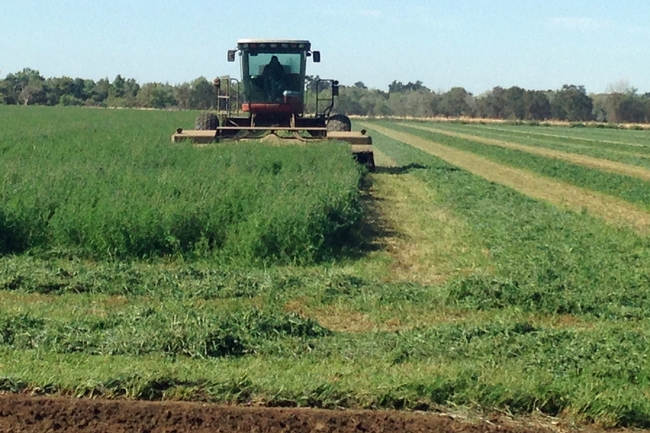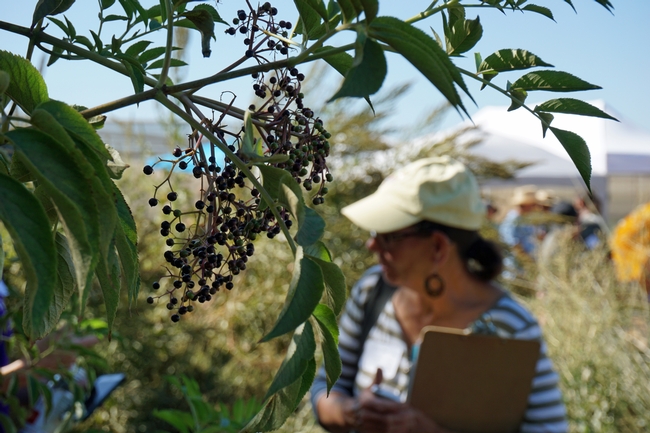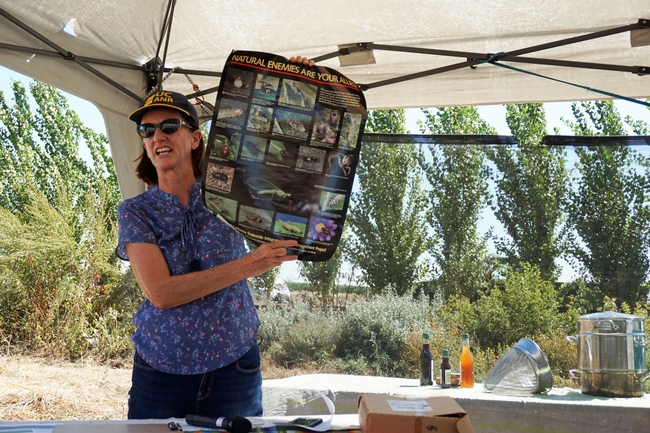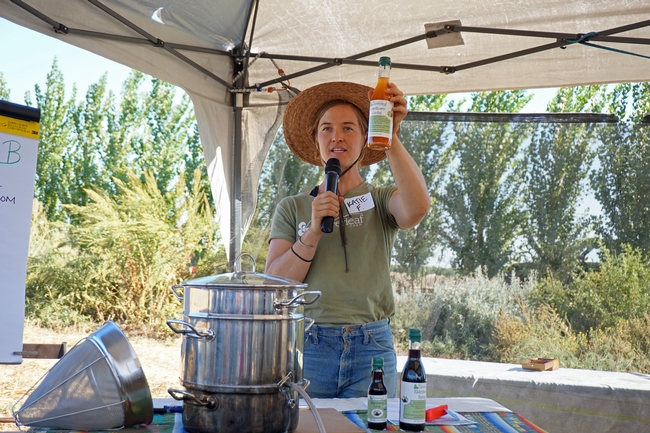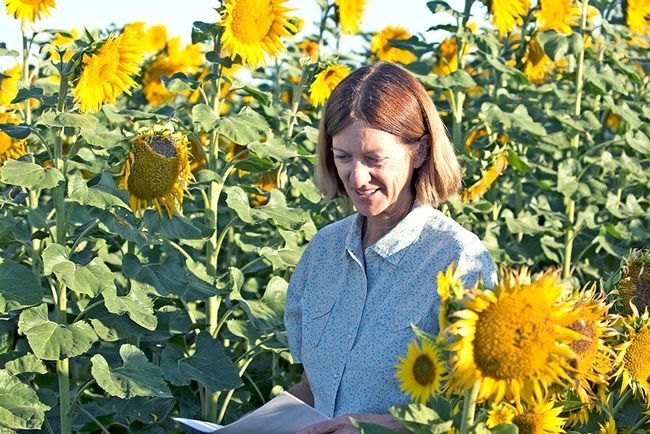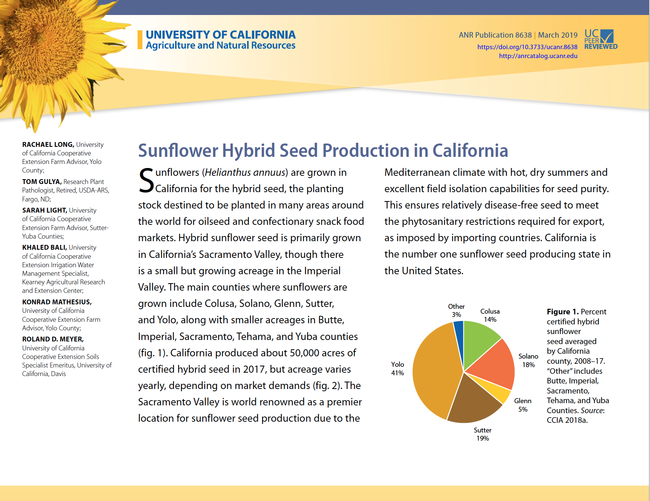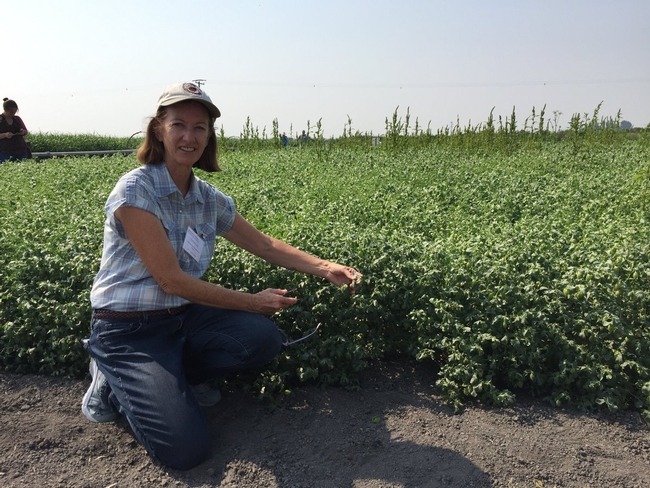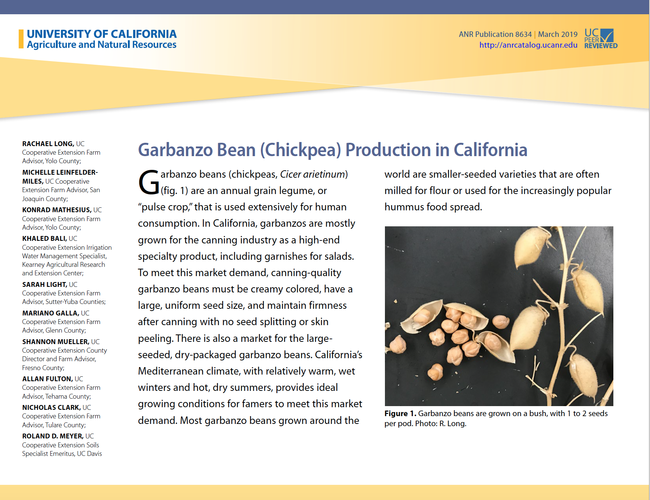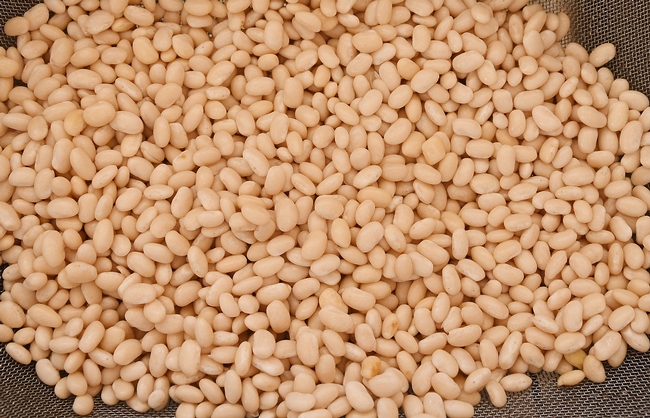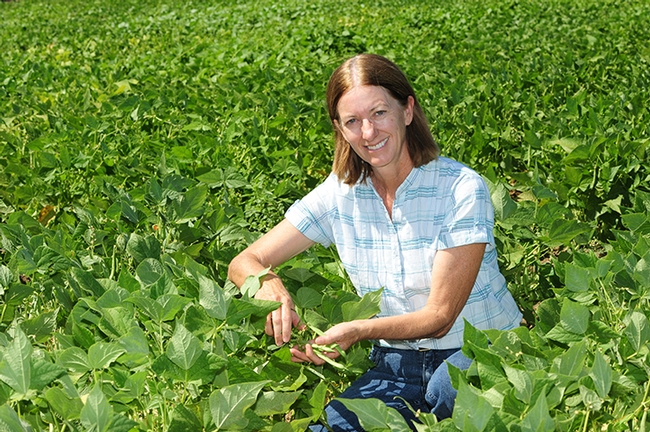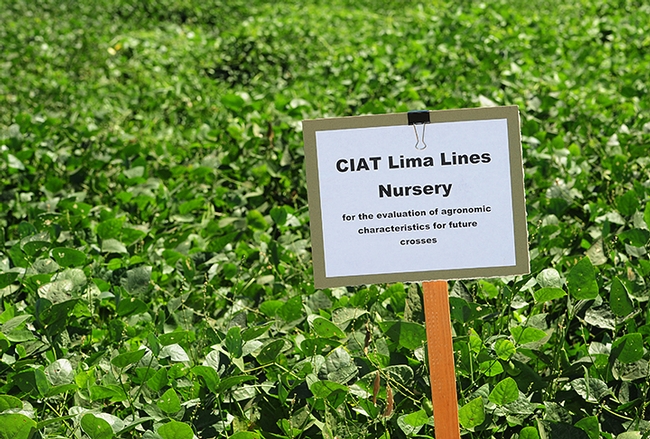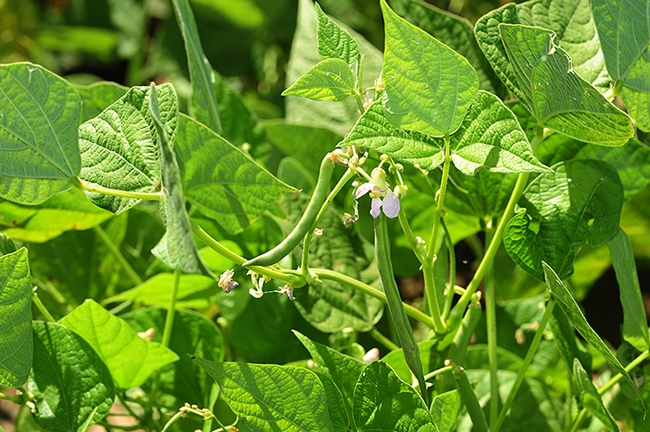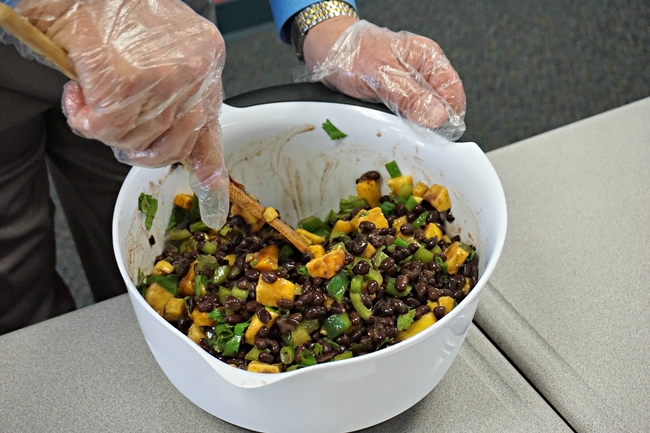Posts Tagged: Rachael Long
Organic alfalfa hay cost study released
A new study that outlines costs and returns of establishing and producing organic alfalfa hay has been released by UC Cooperative Extension, the UC Agricultural Issues Center and the UC Davis Department of Agricultural and Resource Economics.
High-quality organic alfalfa hay is an important ingredient in milk-cow feed rations for organic dairies. Organic dairy farms are required to use organic feed and allow cows to graze for part of their forage. Organic alfalfa hay comprises a major source of forage for the industry.
In 2019, organic dairy farms in California produced about 900 million pounds of milk — just over 2% of California milk output production, according to co-author Daniel Sumner, director of the UC Agricultural Issues Center and professor in the UC Davis Department of Agricultural and Resource Economics.
“Demand for organic alfalfa production has grown, including demand from dairy, horse, sheep, goat, and beef producers, but is still a small share of total alfalfa production,” said Daniel Putnam, UC Cooperative Extension forage specialist in the Department of Plant Sciences at UC Davis and co-author of the study. “However, understanding organic production methods and costs is very important for California's organic hay farmers.”
The new study estimates the costs and returns of establishing and producing organic alfalfa using flood irrigation in the Sacramento Valley, north and south San Joaquin Valley, and the Intermountain Region. The 100 acres of organic alfalfa is rented for $345 per acre annually and the alfalfa stand life is four years after the establishment year.
Input and reviews were provided by UCCE farm advisors and specialists and growers. The authors describe the assumptions used to identify current costs for organic alfalfa establishment and production, material inputs, cash and non-cash overhead and a ranging analysis table, which shows profits over a range of prices and yields.
“This cost study provides information on how to grow alfalfa hay organically,” said Rachael Long, study co-author and UC Cooperative Extension farm advisor in Yolo County. “The research that went into developing these practices represents a significant investment by UCCE farm advisors and specialists and California alfalfa farmer collaborators. We are pleased to team up with economics and cost study experts to provide this study, which indicates potential profits in growing this crop for the organic dairy market.”
The new study, “Sample Costs to Establish and Produce Organic Alfalfa Hay, California - 2020” can be downloaded for free from the UC Davis Department of Agricultural and Resource Economics website: http://coststudies.ucdavis.edu. Sample cost of production studies for many other commodities are also available on the websites.
For an explanation of calculations used in the study, refer to the section titled Assumptions. For more information, contact Jeremy Murdock, UC Agriculture and Natural Resources, Agricultural Issues Center, Department of Agricultural and Resource Economics, at (530) 752-4651 or jmmurdock@ucdavis.edu. To discuss this study with a local extension advisor, contact the UC Cooperative Extension office in your county: https://ucanr.edu/About/Locations.
California elderberries have rich benefits for farms and diets
Native California elderberries can be found at the intersection of sustainable farming, super nutrition and economic viability. Naturally drought tolerant, flavorful and packed with nutrients, they are capturing the interest of farmers, health-conscious consumers and scientists.
Elderberries were the focus of a field day offered by UC Agriculture and Natural Resources Sustainable Agriculture Research and Education Program (SAREP) in September at Cloverleaf Farm, an organic berry and tree fruit operation in Dixon.
Elderberries occur naturally around the world. In California, Native Americans used the tree's stems for making flutes, berries for food and purple dye, and bark, leaves and flowers for their purported anti-inflammatory, diuretic and laxative properties.
“They had a relationship with the plant for food, medicine and music,” said SAREP academic coordinator Sonja Brodt. “We wish to honor the elderberry's history here and thousands of years of management by California native tribes.”
UC Cooperative Extension advisor Rachael Long said elderberries are her favorite native plant.
“They're pretty in the spring and summer. The flowers smell like cloves. It's a wonderful fragrance,” she said.
But perhaps the best attribute of elderberries for Long, a proponent of planting hedgerows on the edges of farmland, is the tree's ecological benefits. Elderberries can be among the rows of trees, shrubs, grasses and sedges in hedgerows that attract beneficial insects and pollinators to farms to help with biocontrol of pests and pollination of plants in adjacent crops.
“Flowering native plants like elderberries, toyon, Christmas berry, coffee berry, manzanita and coyote brush provide nectar and pollen for native bees, honey bees and other insects,” Long said. “I see a lot of green lace wings (predators of aphids, spider mites and other pests) in elderberry.”
Long reported that a tomato farm didn't have to spray as much for aphids because of the beneficial insects attracted by the hedgerow. “They saved $300 per acre each year,” she said.
Hedgerows require long-term planning and care, including weed control. Establishing a hedgerow costs about $4,000 for a 1,000-foot-long planting with a single row of shrubs and trees bordered by native perennial grasses. At that rate, Long has calculated that a return on investment in pest control takes about 15 years. For pollination, the return on investment is about 7 years.
Installation of hedgerows can be eligible for cost sharing with USDA's Natural Resources Conservation Service Environmental Quality Incentives Program. Costs can also be offset by harvesting the elderflowers and elderberries in the hedgerow and making value-added products – such as syrups and jams – or selling the flowers or berries to a processor.
Farmer Katie Fyhrie shared how Cloverleaf Farm is managing elderberries in a hedgerow, harvesting flowers in the spring to make and bottle elderflower cordial, and harvesting berries in the fall to produce and bottle deep purple sweet-tart syrup. Sixteen ounce bottles of cordial and syrup sell for $12 each. The cordial and syrup are ideal for serving with seltzer and ice for a fruity and uniquely wild-tasting drink.
Fyhrie is also working with Brodt of SAREP to gather data for research on best production practices, farm and processing labor costs, and yield comparison between native plants and named varieties from the Midwest. The study includes data from three California farms.
The project is a collaboration among the UC Sustainable Agriculture Research and Education Program (a program of the Agricultural Sustainability Institute at UC Davis), the UC Agricultural Issues Center, the UC Davis Department of Food Science and Technology and four farmers to assess the farm management practices, cost, nutritional content, and market potential of California elderberries.
While laboratory research comparing the nutritional characteristics of the California blue elderberry with the North American black and the European black is continuing at UC Davis, food science professor Alyson Mitchell and her graduate student Katie Uhl were able to share what is already known about the nutritional benefits of the fruit.
They said elderberries are high in vitamin C, dietary fiber, phenolic acids and anthocyanins. Elderberries contain antibacterial, antioxidant and anti-inflammatory agents. While they have a strong history as a treatment for colds and flu, more studies are needed to understand their medicinal use, Mitchell said.
The field day in Dixon was among the first outcomes of the two-year project. A growers' production guide, cost of production study, an assessment of market demand and nutritional analyses are also planned. The information will be made available, along with other resources on elderberry cultivation and processing, on the ASI website.
California takes the lead on hybrid sunflower seed production
Enjoying a tasty sunflower seed snack? Cooking with sunflower oil? Thank a California sunflower seed grower for producing the hybrid seed that's used for planting sunflower crops throughout the United States and the world, for confectionery and oil seed production.
California farmers grow about 70,000 acres of sunflower, mostly in the Sacramento Valley, for hybrid seed stock.
“We have perfect conditions for growing sunflowers, with hot, dry summers and plenty of good irrigation water for producing high quality seed,” says Rachael Long, UC Cooperative Extension farm advisor in Yolo, Solano and Sacramento counties. “We also have good pollination by honey bees and field isolation from wild sunflowers, needed for high yields and genetic purity of planting seed stock.”
Indeed, take a look at the lovely fields of sunflowers blooming in the summertime. Their striking show of bright yellow faces across the valley's vast agricultural landscapes elicit feelings of warmth and happiness.
“But don't stop there!” says Long. “Take a closer look at the fields and you'll see rows of plants with single large flowers alternating with rows of smaller plants with multiple flowers. Stalks with single flowers are female, smaller ones are male; cross pollination occurs by honey bees to produce the hybrid planting seed, harvested from the single female flowers.”
To assist farmers in producing hybrid sunflower seed crops, Long led a team of researchers to produce a new 2019 sunflower hybrid seed production manual for California. The manual provides information on production needs, such as irrigation and nutrient management, as well as a color guide to insect pests, diseases, and weeds of concern for hybrid sunflower seed production.
“In order to ship seed to worldwide markets, strict field certifications are in place to ensure that pests endemic to California are not spread elsewhere,” Long says. Weeds, insects and diseases growers should watch for are identified in the manual.
“Sunflower Hybrid Seed Production in California” is available for free download at https://anrcatalog.ucanr.edu/Details.aspx?itemNo=8638. In addition to Long, authors of the manual include UC Cooperative Extension farm advisors Sarah Light and Konrad Mathesius, retired USDA plant pathologist Thomas Gulya, UC Cooperative Extension irrigation specialist Khaled Bali, and emeritus UC Cooperative Extension soils specialist Roland Meyer.
“A special thanks to the sunflower seed industry and associate editor Dan Putnam, UC ANR agronomist at UC Davis, for their extensive contributions to this manual to make it a valuable resource for sunflower seed growers,” Long adds. “All of us are also grateful to UC ANR Communication Services for putting together a high quality publication!”
Garbanzo bean production guide published for small but thriving industry
Try topping your salads with some tasty garbanzo beans this summer. Not only are they a healthful source of protein, vitamins and minerals, but the ‘green' legumes are produced in California with a small environmental footprint!
California farmers grow about 10,000 acres of garbanzo beans, mostly for the canning market.
“We have the right growing conditions, including cool, wet winters and hot, dry summers, to produce high-quality, large, creamy-white garbanzo beans for high-end markets, like salad bars,” says Rachael Long, UC Cooperative Extension farm advisor for Sacramento, Solano and Yolo counties. “Other areas, such as Washington State, grow a smaller garbanzo bean destined for processing, like hummus, a creamy vegetable spread.”
Garbanzos, also called chickpeas, are originally from the Middle East, where they have been farmed since ancient times. In California, their heritage dates back to the Spanish Mission era. California garbanzo beans are grown in the winter time, minimizing water use. The nitrogen-fixing legumes supply their own nitrogen and require few pesticides for production as the plants secrete acids that ward off insect pests.
To assist farmers in production practices, Long led a team of researchers to produce a new 2019 Garbanzo (chickpea) production manual for the dry bean industry in California.
“This is a great resource for farmers and the industry,” says Nathan Sano, manager for the California Dry Bean Advisory Board, about the publication, which covers garbanzo production from seed selection to harvesting and markets.
The manual identifies garbanzo varieties that have pest and disease resistance. Nutrient management information helps growers comply with regulations for protecting groundwater from nitrate. The irrigation section provides tables on water needs for crops grown in different areas of California, helping to conserve water.
“Our UC ANR Grain-Legume workgroup started this production manual back in 1992,” Long said. “I'm thankful for a strong team and grower and industry input and support. I also appreciate the incredible mentoring and reviews of this manual by Roland Meyer, UC Cooperative Extension emeritus soil specialist, and a fantastic editor, UC Cooperative Extension agronomy specialist Dan Putnam, to make this publication a reality. This was a big group effort, and I appreciate everyone's contributions to make this a valuable resource for the California dry bean industry.”
The California garbanzo bean production manual is available for free online at https://anrcatalog.ucanr.edu/Details.aspx?itemNo=8634.
In addition to Long and Meyer, co-authors include UC Cooperative Extension farm advisors Michelle Leinfelder-Miles, Konrad Mathesius, Sarah Light, Mariano Galla, Shannon Mueller, Allan Fulton and Nick Clark, and UC Cooperative Extension irrigation specialist Khaled Bali.
'Know beans' about a delicious Thanksgiving
Beans are one of civilization's earliest cultivated crops, dating back to the early seventh millennium BCE. Today there are more than 40,000 varieties of beans worldwide.
Beans can also have a place on the Thanksgiving table. The Maple Spice blog for vegans shares a meat-free substitute for turkey that combines mashed white canelli beans, nutritional yeast, vital wheat gluten and spices to create a loaf that slices like turkey breast. UC CalFresh, one of the UC Agriculture and Natural Resources' nutrition education programs, developed a recipe for black bean and mango salad that makes a healthful and colorful accompaniment to a traditional Thanksgiving meal. (The recipe is below.)
"Not only are beans a healthy food choice, but they are also a healthy choice for our world," said UC Cooperative Extension advisor and dry bean expert Rachael Freeman Long. "Beans fix most of their own nitrogen so require fewer inputs for production compared to other sources of protein and they're cheap! Plus some, like garbanzos, are grown during the wintertime, so they're less dependent on irrigation."
The different varieties of beans include garbanzos (chickpeas) as well as black eyes, limas, and common beans like pintos and kidneys.
You probably won't find a bigger fan of beans than Rachael Long. "I eat them at least once a week or more," she said. "I love going on our Cal Beans website and getting new recipes. Summer time, I love beans on my salad, especially garbanzos. At this time of year, I love soups with beans. My favorite is the kale white bean sausage soup. If I want to go vegetarian, I'll leave out the sausage or sometimes fry up some tofu sausage for flavor. And, it just so happens that this is the soup in the current bean blog. I got the original recipe from one of our nutrition staff at our office."
Long says that Cal Beans is an important site for bean growers and industry folks, too. "It's supported by the California Dry Bean Advisory Board, an important funding source for my work. Right now, I have a grant to look at seed moisture and quality at harvest (possibly drying down seed too much at harvest results in internal injury to planting beans (seed stock)."
What do you know about beans? Do you know that California grows the canning quality beans?
"We have the perfect weather conditions for those large, creamy beige-colored beans," Long said. "Other states like Washington grow about 100,000 acres of garbanzos for humus (but a lower quality bean and we can't compete with their free water via rainfall."
California farmers supply virtually all of our country's dry lima beans, Long notes. In 2012, California farmers grew about 23,000 acres of baby and large limas, valued at $30 million that year, according to the National Agricultural Statistics Service.
Long has authored two UC ANR manuals about beans (Lima Bean Production in California and Common Dry Bean Production Manual) and is just finishing the garbanzo production manual (it's in peer review).
"Lima beans are a major dry bean crop for California, representing a significant portion of the total dry bean acreage in 2013," she wrote in the Lima Bean Production in California. "Lima beans are primarily grown for the dried edible white bean in California, although a limited but stable acreage is also for seed production. As with all dry beans, limas are a nutritional and healthy food choice, being an excellent source of protein, fiber, vitamins, and minerals. Lima beans are also an important rotation crop for farmers because the plants fix nitrogen, add biomass to the soil, and require relatively few pesticides."
Lima beans belong to the species Phaseolus lunatus, distinct from the common bean, P. vulgaris.
"Common dry beans include the market classes kidney, cranberry, pink, black, white, yellow, pinto, and red, all of which are different types of a single species (Phaseolus vulgaris) that was originally domesticated several thousand years ago in the areas that are now Mexico and South America," Long wrote in the Common Dry Bean Production Manual. "Natural selection and breeding programs lead eventually to the current market classes, which are mainly distinguished by seed size, color, and shape, and plant growth habit. Currently, there are no commercially available genetically modified varieties of P. vulgaris."
"Dry beans," Long points out, "are grown in California mainly for human consumption, though a limited but stable acreage is dedicated to seed production. Dry beans are nutritious: they are high in starch, protein, and dietary fiber, they have no cholesterol, and they are an excellent source of iron, potassium, selenium, molybdenum, thiamine, vitamin B6, and folic acid. The U.S. Department of Agriculture considers dry beans to be both a vegetable and a protein source."
Rosane Oliveira, director of the UC Davis Integrative Medicine Program and an adjunct assistant professor in the UC Davis School of Medicine's Department of Health Sciences, recently praised beans as one of the "Fab 4" plant foods in her "21-Day Food Challenge" blog.
Beans are brilliant, Oliveira says, because they:
Indeed, there's even a National Bean Day, observed annually on Jan. 6. Want to know more about beans? You'll find a wealth of information about dry beans from the U.S. Dry Bean Council.
Bottom line: Beans should be an important part of your diet. You can call them "nutritious," you can call them "delicious," or you can call them "brilliant." They're all three.
UC CalFresh mango and black bean salad
Ingredients:
- 1 15-ounce can black beans, rinsed and drained
- 2 cups peeled, pitted and diced fresh mango (about 2 small mangos)
- 1/4 cup sliced green onions
- 1/4 cup chopped bell pepper
- 2 tablespoons lime juice
- 2 tablespoons 100% orange juice
- 1 tablespoon chopped fresh cilantro
- 1/2 teaspoon chili powder
- 1/4 teaspoon ground cumin
Mix together all ingredients in a large bowl. Salad may be served right away, but is best if covered and chilled for a least 1 hour for flavors to blend.


